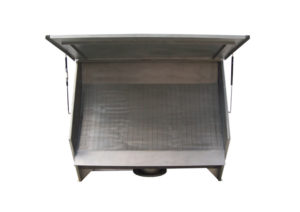
An Economical Alternative for Municipal Primary Sewage
Sidehill static screens are free-standing, easy-to-install and have no motor or moving parts to wear out resulting in a low maintenance solution. Yet the screen is an effective solids separation device as gravity does the work.
Sidehill static screens are typically used when solids are easily separated from liquids and when the separated solids slide easily on a sloped surface. Wastewater flows by gravity into the headbox where it then overflows a distribution weir onto a steeply sloped parabolic screen filter surface. Liquid passes through the openings in the wedge wire to a drainage pan while the solids slide down the surface of the screen to the discharge lip where the liquid is recirculated or discharged.
JWC Environmental offers two Sidehill Screen options, the SHP and SHS.
The SHP series works by using pressurized, incoming feed combined with an oscillating spray system, ensuring a higher capture rate for fine solids recovery.
The SHS sidehill static screen (also known as a parabolic or rundown screen) has a simple design and is ideal for static dewatering screen applications, especially in a bypass or overflow channel where the screen sees only occasional use.
Benefits
- Little to no maintenance
- Simple but dependable design
- Low operating cost
- Easy installation
Features
- 304 stainless steel or alloy 20 construction
- Vapor enclosure (cover)
- Solids discharge chute
- Rear-oscillating of front-travelling spray bar
- Customized inlets and discharge
Specifications
- SHS Static Screen widths range from 12 to 120 inches (300 – 3050 mm)
- SHS flows up to 2000 gpm ( 454 m3/hr)
- SHS Dewatering Screen decks are offered in 38, 42 or 54-inch lengths
- SHP hydraulic capacity: 300-600 gpm (68 to 136 m3/hr)per single unit, depending on the application
- SHP Dewatering Screen decks are offered in 24, 48 or 72-inch lengths
Wastewater & Processing Solution Products
Contact a Representative
Find out more today about how JWC can fulfill your grinding, screening, shredding or processing needs.

